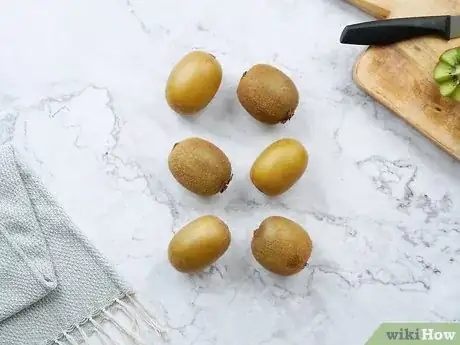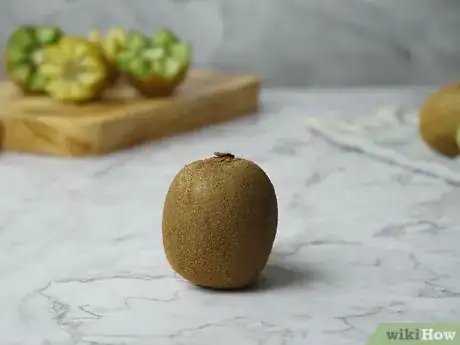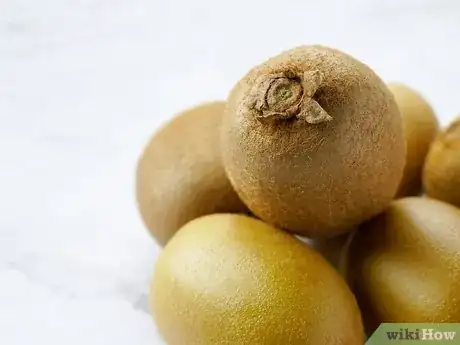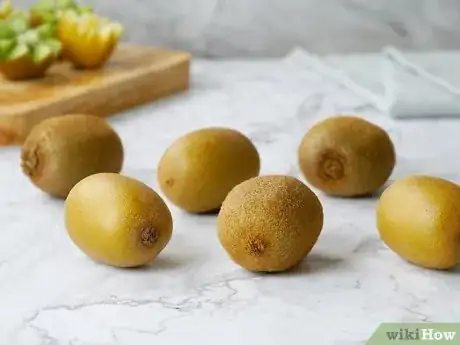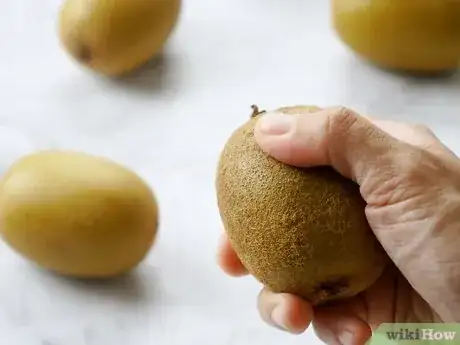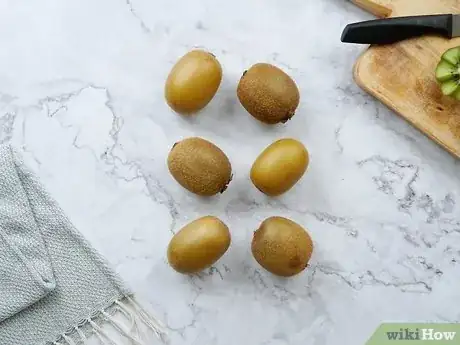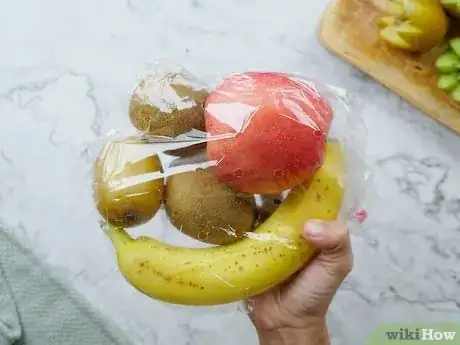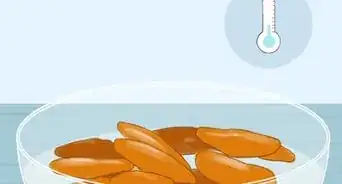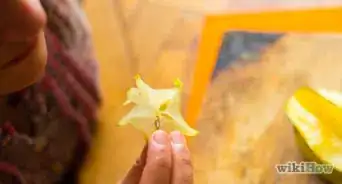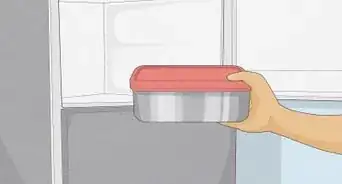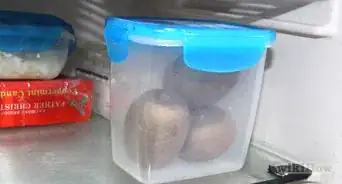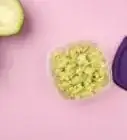This article was co-authored by wikiHow Staff. Our trained team of editors and researchers validate articles for accuracy and comprehensiveness. wikiHow's Content Management Team carefully monitors the work from our editorial staff to ensure that each article is backed by trusted research and meets our high quality standards.
The wikiHow Video Team also followed the article's instructions and verified that they work.
This article has been viewed 88,823 times.
Learn more...
A kiwi is plump fruit that has green flesh and a sweet taste. To figure out if one is ripe, you can first assess its surface, looking for a brown color and plump shape. Then you should feel it and smell it, making sure it is slightly soft and smells sweet and fruity. If all the signs are right, you have a ripe kiwi on your hands.
Steps
Inspecting the Surface
-
1Look for an entirely brown skin. A ripe kiwi will have brown skin, including the fuzz on the surface and the skin underneath. If the fruit is totally green or you can see green under the fuzzy surface, then the kiwi is not yet ripe.
- This should not be the only factor that you test on a kiwi to determine if it's ripe. It is only a first step to determine if the fruit is anywhere near ripe.[1]
-
2Look for a plump shape. A ripe kiwi is typically plump and bulbous, with a full and round shape. However, if the surface looks hard and firm instead of plump, then the kiwi is probably not ripe yet.[2]
- A surface that is wrinkled and is not smooth usually occurs when a kiwi is overripe and has dried out.
Advertisement -
3Smell the kiwi. Put your nose close the spot where the kiwi was attached to the vine and smell for a slightly sweet and fruity scent. A ripe kiwi has this distinctive smell, while an unripe kiwi doesn't really have a smell at all.[3]
-
4Look for an undamaged and unblemished surface. When assessing whether a kiwi is ripe it's best to pick one to look at that has a pristine surface. This will help ensure that the kiwi you are looking at is not damaged, as soft spots can trick you into thinking the fruit is ripe when it's not.
- Severe blemishes and brown spots occur on both overripe kiwis and kiwis that have been dropped or otherwise damaged.
Feeling and Testing the Fruit
-
1Squeeze the kiwi gently. Pressing on the fruit with your thumb, feel for a soft but firm texture. The flesh should give slightly when you press on it if it is ripe.
- If you squeeze the fruit and it is very hard, the fruit is not ripe.
- If you lightly squeeze a kiwi and it feels very soft or mushy, it is overripe.
-
2Inspect the inside of the fruit. If you suspect a kiwi is ripe but you're not quite sure, it is best to cut it open and inspect the flesh. The seeds of a ripe kiwi will all be black and the flesh of a ripe kiwi will have a bright green color if it is a green kiwi and bright yellow flesh if it is a golden kiwi.[4]
- If your kiwi is not ripe, the seeds may be green or yellow and the flesh will not be as brightly colored.
-
3Do a taste test. The definitive way to know if a kiwi is ripe is to taste it. Remove the thin skin, with a peeler, a knife, or by scraping it off with a spoon, and then cut off a slice of the fruit. The flesh should be soft and squishy and the flavor should be sweet.[5]
- An under ripe kiwi will not be sweet and will be firm instead of soft.
- While you can eat the skin of a kiwi, many consider it unpleasant due to its fuzzy texture.[6]
Helping an Unripe Kiwi Ripen
-
1Let the kiwi ripen on your counter. If you don't need to eat an unripe kiwi right away, simply let it sit on the counter and ripen naturally. It will gradually ripen over the course of several days, depending on the temperature and how ripe it was to begin with.[7]
- The warmer the room is, the quicker the kiwi will ripen.[8]
- Check the kiwi daily for ripeness. Eat it right away once you think it is ripe.
-
2Put your kiwi in a bag with other fruit. If you need your kiwi to ripen within a day or 2, put them in a paper or vented plastic bag with an apple or banana. Putting them together exposes the kiwi to more ethylene gas, which is given off by fruit and causes them to ripen.[9]
-
3Keep unripe kiwi in the fridge until you want to ripen them. Kiwi can be stored in your fridge for weeks, and sometimes months, if they are not yet ripe. Preserving them this way will allow you to ripen a few at a time, so you can eat them gradually.[10]
Community Q&A
-
QuestionIs it unsafe to eat an unripe Kiwi?
 Community AnswerNo, but it will be more acidic and have a more bitter taste, and may disagree with your digestion.
Community AnswerNo, but it will be more acidic and have a more bitter taste, and may disagree with your digestion.
References
- ↑ https://www.finecooking.com/article/choosing-fruit-thats-truly-ripe
- ↑ http://www.calharvest.com/kinutr7.html
- ↑ http://www.calharvest.com/kinutr7.html
- ↑ https://www.healthline.com/nutrition/eating-kiwi-skin
- ↑ http://www.calharvest.com/kinutr7.html
- ↑ https://www.healthline.com/nutrition/eating-kiwi-skin
- ↑ https://www.finecooking.com/article/choosing-fruit-thats-truly-ripe
- ↑ https://spoonuniversity.com/lifestyle/4-genius-ways-to-quickly-ripen-a-kiwi
- ↑ http://extension.oregonstate.edu/lane/sites/default/files/images/sp50832.pdf
About This Article
To check the ripeness of the kiwi, look for an outer skin that’s unblemished and completely light brown all over, including the fuzz. The kiwi should also be plump and firm, but you should feel a slight give when you squeeze it. A kiwi that’s mushy or wrinkled is overripe. Give the stem end of the kiwi a sniff. If it smells sweet and fruity, that’s a good sign. An underripe kiwi may have no smell at all. If you’re still in doubt, cut the kiwi open. Look for bright green flesh and black seeds. Some kiwi varieties may have bright yellow flesh instead. Ripe kiwi flesh will also be soft and sweet. For more tips, including how to help ripen a kiwi, read on!
